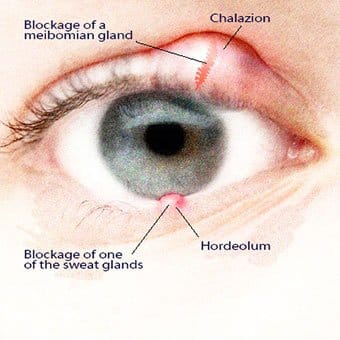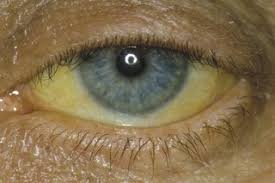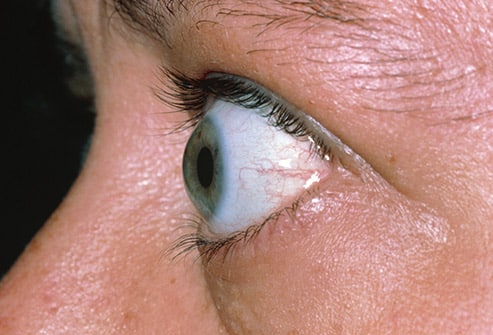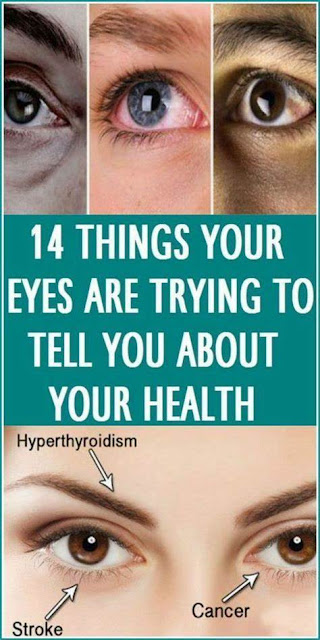Did you know that your eyes can say a lot about your health? Learning about the signs and symptoms of different eye problems can help you seek immediate medical help and prevent larger health issues in your body.
Here are things your eyes say about your health and you can notice them just by looking in your eyes:
1. Disappearing Eyebrows
If you notice that a third of your eyebrows fall out, it may indicate a thyroid disease that can be either due to overactive thyroid gland or underactive thyroid gland.
Thyroid hormones are important for the production of hair. So, if you start noticing the thinning of eyebrows and uneven brow hair loss, or early greying, then it’s a sign of thyroid problem.
2. A Stye That Won’t Go Away

A small, raised, often reddish bump along the inner or outer eyelid margin is called a stye. If it stays of more than three months or it keeps re-occurring in the same area, it indicates that you are suffering from rare cancer called sebaceous gland carcinoma.
A cancerous cyst mimics a stye and is also characterized by the loss of eyelashes around the stye.
3. Burning Eyes, Blurry Vision While Using a Computer
This is commonly known as the “computer vision syndrome” (CVS). Eyestrain occurs due to the lack of contrast on a computer screen, and the extra work involved in focusing on pixels of light. This causes the dryness of the eyes as the ability to produce lubricating tears decreases.
This results in eye irritation, blurred vision, and discomfort. People who wear glasses or contact lens or binge watch Netflix are at higher risk of CVS if they work long hours using computers especially old models. Flat-panel LCD display screens cause less eye strain.
4. A Small Blind Spot In Your Vision, With Shimmering Lights Or a Wavy Line
This issue may or may not be followed by a headache, and it appears as a result of a migraine aura also known as ophthalmic migraine.
You may experience disturbed vision as you get to see the bright dot or a line in the centre of the field of your vision. Though painless, it’s quite uncomfortable and prevents your focus on the work. Early diagnosis and treatment can prevent serious concerns like a retinal tear.
5. Whites of the Eye Turned Yellowish

This condition is commonly known as jaundice and it mainly affects newborns with immature liver function as well as those suffering from bile ducts, gallbladder, and liver issues.
The yellowish colour develops due to the buildup of bilirubin, the by-product of old red blood cells the liver can’t process.
However if you notice just a small yellowish patch or bump on the whites to the side of your iris, it indicates effects of ultraviolet light on your eyes or wearing contact lens.
6. Eyes That Seem to Bulge

The most common cause of protruding eyes is hyperthyroidism (overactivity of the thyroid gland). However, if this is a common issue running in your family then it is less likely to be hyperthyroidism.
You must immediately visit the doctor if the protruding eyes are accompanied by other symptoms like blurry vision, weight loss, fatigue, restlessness, and palpitations.
7. Sudden Double Vision, Dim Vision, or Loss of Vision
These are the visual warning signs of a stroke or brain aneurysm. Problems with cornea or lens or weakened or paralyzed eye muscle can prevent the eyes from aligning properly resulting in double vision or dim vision.
8. Blurred Vision in a Diabetic
Diabetics are at increased risk for several eye problems, but the most common is diabetic retinopathy, in which diabetes affects the circulatory system of the eye. It’s the leading cause of blindness in American adults.
Your eyesight is one of your most precious senses but it’s easy to take the gift of sight for granted, until it starts to fail. Unfortunately, one of the leading causes of blindness in American adults is a side effect of diabetes. This is disconcerting when you consider that today, nearly 1 in 4 Americans are either pre-diabetic or diabetic.
The increased use of computers and video display terminals (VDTs) at home and work has also led to an increase in vision problems due to eye strain.
9. Iridology—Your Eyes as the Mirrors of Your Health?
The Yahoo Health article above brings up several interesting correlations between your eyes and your overall health by hinting at potential underlying health problems. Iridology, or iridodiagnosis, which is the study of the iris of your eye, is yet another technique in that same vein, used by some alternative health practitioners.
This theory goes back to the mid-17th Century, but iridology has yet to be recognized by mainstream medicine. In fact, the majority of medical professionals scoff at the idea.
The basic theory behind this technique is that various characteristics, such as patterns and colors, in specific zones of your iris can provide information about your systemic health. This is done by carefully examining your iris and matching it to iris charts. Using these charts, an iridologist can help identify systems and organs in your body that may be inflamed, or over- or underactive. It cannot, however, diagnose specific diseases—all it can do, at best, is give an indication of your systemic strengths or weaknesses.
10. Antioxidants—Your Greatest Allies for Healthy Eyes
The job of an antioxidant compound is to neutralize dangerous free radicals in your body, including your eyes. A few of the antioxidants that have been shown to be of particular benefit to your eyes include:
Lutein
Zeaxanthin
Black currant anthocyanins
Astaxanthin
Here, I will discuss lutein and astaxanthin in particular as they are potent allies in the prevention of eye problems.
11. Lutein Aids in the Protection of Your Central Vision
Macula lutea contain high concentrations of zeaxanthin and lutein.
It is believed that they have 2 important roles, and they are absorption of excess photon energy, and quenching free-radicals in the body before damaging the lipid membranes.
The miniature central part of the retina, called macula, is responsible for detailed and straight-ahead vision.
It contains the highest amount of lutein in our eyes.
In other words, lutein helps in the protection of out central vision.
This naturally occurring carotenoid can be found in orange and yellow fruits and veggies, as well as in green leafy veggies.






0 komentar